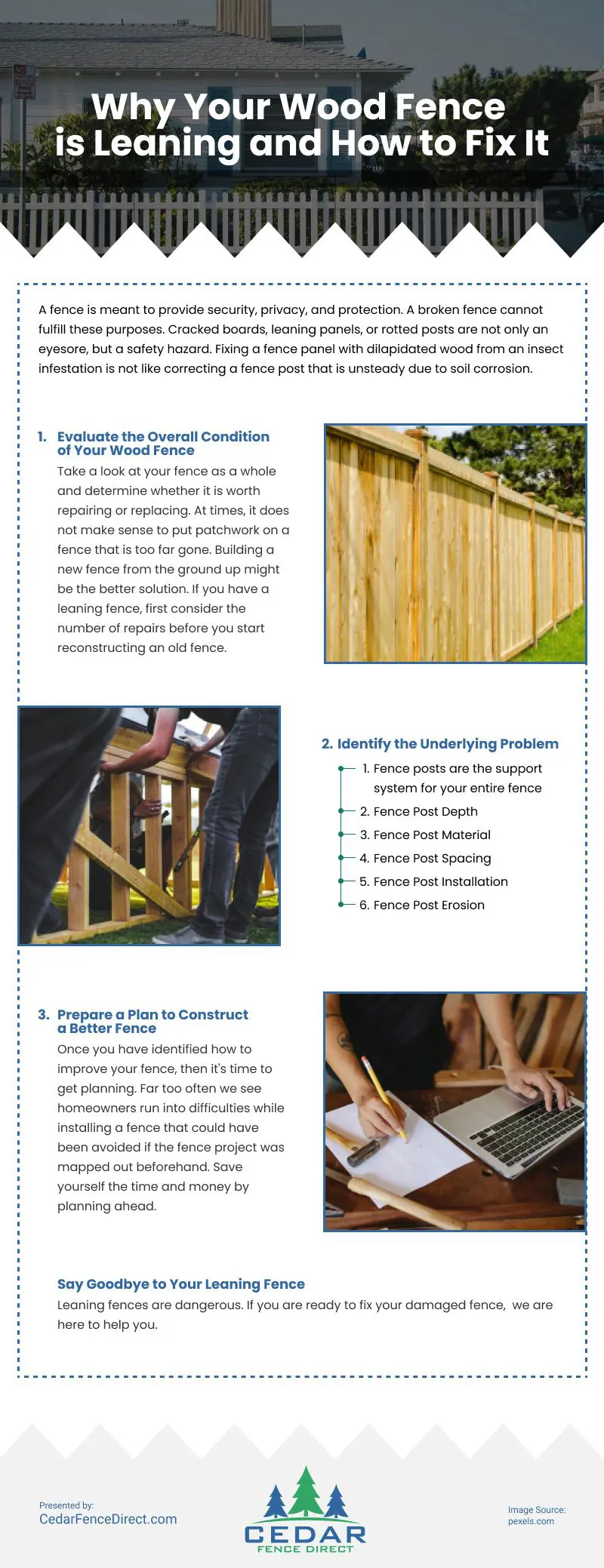
A fence is designed to offer protection, seclusion, and security. It makes a yard more attractive, discourages trespassers, raises property value, defines boundaries, obstructs passersby’s views, and aids in keeping kids and pets contained.
Repairing any issues with your fencing should be your top concern. But there are many other kinds of maintenance that a fence could need. What should you do if you see that your wooden fencing could use some maintenance? What can you do, specifically, to fix a leaning fence? Let’s take a closer look at our three-step plan for assisting homeowners in making sure their wood fence is a reliable structure:
#1 Assess The General State of Your Wood Fence
Take a step back and examine your fence as a whole before you begin any significant fence modifications. You can use these inquiries to decide whether it would be better to repair or replace your fence. Patching up a too-damaged fence occasionally is not the best course of action. Before you rebuild an old fence, take into account how many repairs are needed, how serious the repairs are, and where they are required. A brand-new fence that is constructed from the ground up might be the superior option.
#2 Determine The Underlying Issue
In this phase of the procedure, you delve further into figuring out the causes of your fence’s failure. For instance, if you don’t have sturdy posts, changing a fence panel won’t accomplish much. The real issue cannot be solved by simply affixing a new fence panel to damaged poles.
One issue, or a combination of issues, such as soil erosion, weather damage, or rotted wood, could be the cause of fence tilting. Your fence’s entire structure is supported by its fence posts. Strong fence posts are the foundation of a strong fence. Let’s examine how the foundational issue causing your fence to topple could be your fence posts.
Fence Post Depth: It’s a bad idea to have a fence post that is too short. Posts must be buried deeply enough to perform their function.
Fence Post Material: Even with a fence post buried down in the ground, problems can still arise. Cheap metal posts have a tendency to corrode and shatter. The strength of a fence post depends on the material used to construct it.
Fence Post Spacing: A problem will arise if fence posts are spaced too far apart. The length, size, and type of wood used to construct your fence all affect how far apart the panels should be placed.
Installation of Fence Posts: There are correct and incorrect ways to install fence posts. You will eventually have a swaying fence if the posts are not set in concrete or gravel.
Fence Post Erosion: This occurs when the soil around a fence post wears away, upsetting the original setting you made for your fence post. Wet weather will harm the earth around your fence post, including snowdrifts, torrential rain, persistent wetness, and soggy circumstances.
#3 Develop a Plan to Build a Better Fence
We advise all homeowners to create a strategy before starting any work. There are homeowners having problems building fences, problems that could have been avoided if they had planned out the fence installation in advance. By making a strategy ahead of time, you can save time and money.
Get Rid Of That Sagging Fence
Fences that lean pose a threat. We are available to assist you if you are prepared to repair your broken fence. We would love to develop a strategy with you to enhance the appearance and functionality of your fence as a wholesale supplier of fences in Colorado.
source: https://cedarfencedirect.com/blog/2022/10/20/why-your-wood-fence-is-leaning-and-how-to-fix-it/
Comments
Download this infographic.
